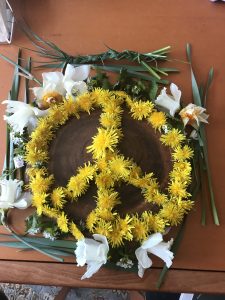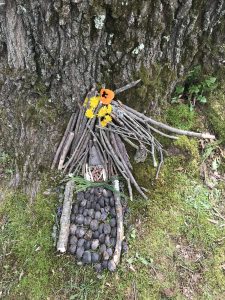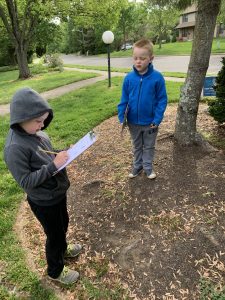Growing Environmental Hope Amid a Pandemic

To view the photo-rich magazine version, click here.
Originally appears in the Summer 2020 issue.
By Helen Corveleyn, Lauren Madden, and Louise Ammentorp
So, we’ve been quarantined, our lives have been forever changed, and we are now stuck in a time of limbo that has a theme song titled: “What if …” What if we never go back to life as we knew it? What if we have to wear masks from now on? What if the North American “handshake” becomes a completely different cultural behavior and we elbow bump into the foreseeable future? There are so many speculations that are circulating right now, because of the unintended consequences of COVID-19. But what if some of the unknowns turn into permanent habits that lead to positive planetary changes?
An unintended positive consequence of the COVID-19 pandemic is that many individuals, families, and communities have defaulted to pro-environmental behaviors in their everyday lives. We are often too busy to grant ourselves the time to reflect on the good; however, in searching for “silver linings” we see a new ecological and educational creativity blooming in our communities. In just seven short weeks, we have seen changes at the household level such as fewer trips to the supermarket, cutting gas usage, decreasing waste, buying local, and increasing food efficiency and creativity at home. Further, more people are spending time outside as a reprieve from the stress of the situation and internet overload. Individuals and families are embracing activities such as gardening, hiking, and other forms of natural recreation. In turn, these household changes yield global impacts. National Geographic recently reported that carbon emissions from China alone are down as much as 18%.[efn_note]Stone, M. (2020). Carbon emissions are falling sharply due to coronavirus. But not for long. National Geographic. Retrieved from: https://www.nationalgeographic.com/science/2020/04/coronavirus-causing-carbon-emissions-to-fall-but-not-for-long/[/efn_note]
In this article, we shed light on some of the ways this pandemic has fostered pro-environmental behaviors in our own lives and in the lives of our students from pre-K to age 16. We make suggestions for teaching practices, inspired by this newfound hopefulness, that enhance green learning experiences, and foster students’ care for the environment.

A gnome home built by the Corveleyn children
Seeking refuge in the comforts of nature
Our lives have changed drastically since mid-March, when we began experiencing nationwide stay-at-home orders. Time, and how we spend it, seemed to transform overnight. We no longer spent time commuting to work, and our leisure (and work) time became home-centered. Though we may lament the loss of certain activities, this loss opened the window to new possibilities. At first, it seemed, everyone was spending their new found time online. Hulu, Netflix and other streaming companies saw huge gains in subscriptions. People also shopped in bulk in preparation for staying home, stocking up on large amounts of dry and canned goods, and of course, toilet paper. As time went on, many people found themselves “Zoomed out” and exhausted from staring at the computer for hours at a time. Parents grew concerned from seeing their children spend hours online for school and then even more hours online for leisure time. Many people began to crave respite and headed outdoors.
There are numerous therapeutic and social-emotional learning (SEL) benefits of nature for both children and adults. Time in nature has been linked to positive outcomes for emotional well-being, ADHD, overall mental health, self-esteem, stress, resilience, depression and health-related quality of life.[efn_note]Tillmann, S., Tobin, D., Avison, W., Gilliland, J., (2018). Mental health benefits of interactions with nature in children and teenagers: A systematic review. Journal of Epidemiology and Community Health, 72(10).[/efn_note] Research has shown that time in nature (even just 15 minutes) fosters many emotional benefits, including enhanced feelings of awe and other positive emotions.[efn_note]Ballew, M. T., & Omoto, A. M. (2018). Absorption: How nature experiences promote awe and other positive emotions. Ecopsychology, 10(1), 26–35. https://doi.org/10.1089/eco.2017.0044[/efn_note] Nature provides us with a place to be curious and it also allows us to reset ourselves in fresh air, sunlight, and birdsong. Instead of single or partnered hikers, one can now observe families that are skipping along natural areas invested in conversations with each other and delighting in the joy of forest bathing, mountain biking, or stream hopping. In northeastern US forests, spring ephemerals open their petals during warm afternoons so the first pollinators can sip their sweet nectar. Children delight in watching the change from winter to spring: a phenomenon we typically take for granted.
How often does a first-grade child get to notice the entire life cycle of a fleeting but very important part of forest ecology?
Simply being in nature frequently and taking time to notice these seasonal changes can help children (and adults) develop science capital, or the thoughts, ideas, and connections an individual has related to science.[efn_note]Archer, L., Dawson, E., DeWitt, J., Seakins, A., & Wong, B. (2015). “Science capital”: A conceptual, methodological, and empirical argument for extending bourdieusian notions of capital beyond the arts. Journal of Research in Science Teaching, 52(7), 922-948.[/efn_note] Research shows that about 95 percent of what people learn about science occurs outside the traditional classroom.[efn_note]Falk, J. H., & Dierking, L. D. (2010). The 95 percent solution: school is not where most Americans learn most of their science. American Scientist, 98(6), 486.[/efn_note] Children and families exploring the outdoors together can notice and discuss these changes, and in turn, build a strong foundation for understanding the ways in which our natural world works. These changes have the potential to shift individuals’ confidence and competence in science, and, in turn, help develop a more environmentally-literate populace. Although trails and parks are ideal locations for exploring, careful observation of the seasonal changes in our natural world can occur anywhere — changes in the sky outside city windows and dandelions growing alongside the road are important reminders to us all. Children can take ownership of their yards through gardening and monitoring changes in animal life. Continuous monitoring of a chrysalis, nest, or creek bed provides observational patterns that are at the heart of scientific discovery. Observing toads, raising caterpillars that turn into butterflies to release, or searching for eggs in bird nests allow children to experience authentic environmental education that is at the heart of inquiry. Teachers and informal educators alike can share the list below to help children and families make sense of how they take in the natural world whether out on a trail or outside their windows.
- Listen! How many different kinds of bird songs can you hear? Can you copy the sounds yourself? Do you notice different sounds at different times of the day? What does that tell us about these birds?
- Ask! Just about every school child can tell us that April showers bring May flowers. But do they? What have you noticed about the rain over the social isolation period? What have you noticed about the flowers? Look through your phone’s camera roll over the last few months. What is different?
- Look! Next time you see a dandelion fluffy and white, look closely at the white parts. What makes it easier or more difficult for them to blow away? Where do the white parts go when you blow on them? What do you think happens once they’ve landed?
- Create! An important way to make deep observations of nature and explore concepts such as symmetry and structure is to integrate arts-based activities. Organize scavenger hunts for various colors, shapes, and textures that can be used in the creation of nature collages, gnome homes, and other structures.
These are just a handful of suggestions that help spark children and families to look carefully.

Connor and Luke Madden marking down observations on a front-yard nature walk
Changes in our kitchens
Most states and provinces have made recommendations to decrease the number of trips outside one’s home, which also means fewer shopping trips to the supermarket. Many families also stocked up on pantry staples and frozen produce early on in the pandemic.
Some families even committed to growing more of their own food by planting seedlings and starting gardens. Together, these changes led to kitchen creativity and more responsible uses of resources.
These changes led us all to have active virtual conversations about waste reduction. For example, a friend shared a photo on Facebook documenting her experience of using every last part of her peppers while cooking. It was captioned, “Cream of Wheat “umpa,” with peas and the tops of sweet red, orange, and yellow peppers. Don’t waste the part around the stem. Look how cute they are!”
Still, others have noticed the waste in their past habits as more time has allowed for cupboard clean-outs and counting the number or extra items in our own kitchens. A friend recently shared a count of cereal “extras” that often go to waste unused: “Who needs three boxes of Cap’n Crunch, four boxes of Honey Smacks, and four boxes of Apple Jaxx? Stale! Stale! Stale!”
The idea of corona cooking has become a trend and picked up by food writers at the New York Times and Bon Appetit! Recipes now come with great discussions about substitutions, interesting ways to incorporate frozen and canned items, and multiple uses for single items. (For some great ideas, see Laskey.[efn_note]Laskey, M. (2020). Easy Recipes to Cook While You’re Self-Quarantined. The New York Times. Retrieved from: https://www.nytimes.com/article/easy-recipes-coronavirus.html[/efn_note]) Corona cooking has also provided opportunities for learning about the process of cooking and the way in which the foods we buy and eat impact our bodies and the planet. Aside from the science process skills that come along with cooking in general (e.g., measuring, weighing, counting) and the observations of the way temperature and time influence changes in ingredients, we can also help families celebrate ways to economize and reduce waste in the kitchen. The list below can also be shared to help foster pro-environmental behaviors in the kitchen:
- Save it! When a recipe calls for one small onion, and all you have is a large one, use half. The other half can be saved for another recipe in an airtight container.
- Grow it! Getting to the end of a bunch of celery or romaine lettuce? Chop off all but a few inches of stalks from the bottom and place them in a small dish of water near a window. Watch the changes right away and put your “new” celery or lettuce to use in a salad in a few weeks.
- Make a game of it! When planning a favorite meal, “shop” your pantry first. What vegetables do you have in cans that could be good substitutes? Can you use the rice you already have rather than the kind listed in the recipe? Can you create something interesting with the spices already on your spice rack? Teenagers in particular are often willing to put their creativity to the test when given the opportunity.
- Share it! Students are involved in virtual demonstration platforms where they are collaborating through classes or virtual play dates.
Teachers or friend groups present a healthy cooking option, and students cook from their own kitchens along with the teacher and other classmates, and then sit down and enjoy what they created together via video conference!
Thinking about the bigger picture
We know that the changes in our everyday lives have resulted in some changes on the global scale. There have been major shifts in atmospheric carbon emissions, but not all in the same direction. Decreases in manufacturing and transport have made a big dent, but increases in home use of electronics may have offset it some. This is a complex and multi-faceted problem that forces individuals to think systemically when brainstorming solutions. Teachers, parents, and families can work together to use tools such as carbon footprint calculators (like this one from the nature conservancy: https://www.nature.org/en-us/get-involved/how-to-help/carbon-footprint-calculator/) to better understand how the changes in energy use influence the “big” global picture.
One hopeful silver lining we can all celebrate is that it is impossible to unlearn the things we notice. Children who are able to observe changes in nature, enjoy a tasty and creative meal full of substitutions, and graphically represent the way COVID-related behavior changes have had global impacts face the world empowered with new knowledge. This knowledge, in turn, will help propel them into a “new normal.” A common trope we hear these days is that “we are all in this together.” Though that is of course true, we are in this together; we each face different circumstances. Let’s make our “what ifs” into opportunities to look more closely, make more ecologically responsible decisions, and use our creativity to help improve our future.
Helen Corveleyn is a Pre-K–5 STEM Facilitator at Hopewell Elementary School in Hopewell, NJ, USA. Her areas of expertise include environmental education, vertical farming, and promoting young women in STEM. She is involved in creating large-scale community conservation projects and creating innovative outdoor spaces for nature-based mindfulness.
Lauren Madden, Ph.D. is an Associate Professor of Elementary Science Education in the Department of Elementary and Early Childhood Education at The College of New Jersey, where she also coordinates the Environmental Sustainability Education minor for pre-service teachers. Her research and teaching advocate for scientific literacy and the health of our planet. She is the New Jersey Regional Editor for Green Teacher.
Louise Ammentorp is an Associate Professor in the Elementary and Early Childhood Education Department at The College of New Jersey. Her research interests include best practices and innovation in teacher preparation and in p-6 classrooms, with a focus on nature-based learning and the arts, outdoor education, and hydroponic gardens.










